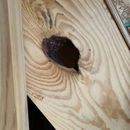Should I do anything about this 2×12
This is a 2X12 that’s on my roof, the hole is only 2 inches in one direction but 3.75 inches in the other direction and the hole is slightly off center, should I tie it some kind of way or is it fine and leave it as is?
GBA Detail Library
A collection of one thousand construction details organized by climate and house part










Replies
Derekr, I am not a structural engineer.
There is this document that applies to 2x lumber *floor joists*. It explains what type of holes you can drill in the lumber (floor joists) without compromising the structural integrity. The guide that is referenced below appears to address holes that are offset from the centre. Having it off centre is different from having it dead centre of the wood.
Also, a drilled hole will act differently than a hole from a natural knot but it is beyond my capacity to explain that in any detail.
Link
https://buildingadvisor.com/wp-content/uploads/2012/05/Notching__Boring_Guide.pdf
When I looked at other guides for manufactured floor trusses, those guides state that the hole size would actully be measured based on the circle you would need to draw - from the centre of the joist - in order to completely capture the smaller hole that is offset. Because I am not a structural engineer, I don't know if that applies to lumber.
In terms of "repairing" this piece of wood if this is what you want to do, you could look at this YouTube video from This Old House. They talk about repairs starting starting at minute 9:00
Link
https://youtu.be/23amU7EWy7g
It’s probably OK. Most of the stress in a joist or rafter is carried in the outer area (near the edges), not the middle portion. This is why TJI joists have fat chords on the outer edges, and a relatively thin web of OSB between the chords.
If you’re really worried about it, glue a piece of 3/4” plywood on either side of the joist extending two feet or so on either side of the open knot. Screw the plywood to the joist to hold it tight while the glue cures. That will reinforce the area around the hole. You want the plywood to be the same depth as the joist.
Bill
Bill’s suggestion of 3/4 ply with PL adhesive is exactly how you would restructure a truss in place for a loft roof cut into an existing trusses. With cuts and bottom chord reframing, skinning the new truss profile on both sides with 3/4” ply is exactly how we put an 11’ partial loft into an existing truss with 8” ceiling.
That hole is likely a zero issue, but PL 24” 3/4” ply cut to the same width as the 2x6 and PL’d in place with screws (both sides) will alleviate any concerns..in fact is overkilll :-)
The knot itself is not likely a problem, because it's in the center of the board's width, where it won't affect the bending strength, which is usually the limiting factor on rafters. If it was near the end of a beam with a heavy load on it, it could fail in shear--i.e., crushing--but rafters rarely have that kind of load.
What is more of a concern is the wood grain near the edges of the board. Structural members are usually required to have grain no more than 10° from straight, because wild grain or cross grain is much weaker than straight grain. This problem is worse the more bending stress there is on the rafter, so if the knot is near the end of the rafter, where bending stress is minimal, I wouldn't worry about it, but if it's near the center, where bending stresses are highest, I would consider sistering it with another rafter. (Solid wood is always stronger in bending than plywood of the same species and dimension, though plywood is stronger in other ways that aren't as important in your situation.)